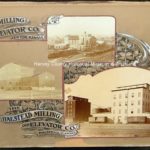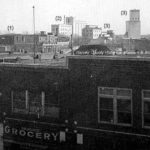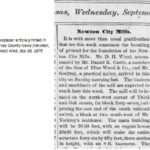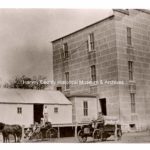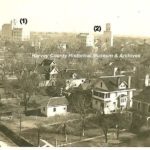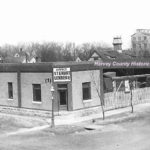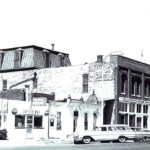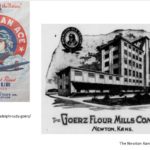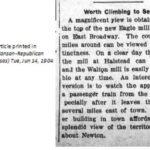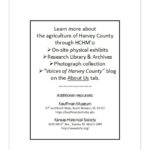Agriculture in Harvey County Stimulated Flour Milling Industry
Turkey Red, a variety of hard winter wheat, was introduced during the mid 1870s into the Kansas counties of Butler, Harvey, Marion, McPherson and Reno. Proving to be hardy and of high yield, the use of this variety of wheat spread across Kansas and then to neighboring states.
In Harvey County, the vast wheat production created new business opportunities in the milling of wheat into flour. As a result, the county had an abundance of flour mills over the years. They were in Burrton, Halstead, Hesston, Newton, Sedgwick and Walton. The growing, harvesting and milling of wheat helped make Kansas “the breadbasket of the world.”
Through on-line exhibits, this slideshow series gives short stories about Harvey County and its cities; and provides a sampling of the stories which can be discovered by viewing the on-site exhibits at HCHM, by examining source material in the Research Library and by utilizing the HCHM photo collection.
For even more stories of Harvey County’s people, events and businesses, check out:
- The Story of Alta Mill. A business of yesteryear that ground flour and feed, Alta Mill was a commercial enterprise situated in Alta Twp of northwest Harvey County. The mill site was a community center due to the park in the nearby woods as well as a meeting point for people from Moundridge, Buhler, Halstead and Burrton. Often getting a year’s supply of flour and feed, farmers brought their wheat from as far west as Meade County, Kansas and south to the Oklahoma line. Learn more about Alta Mill HERE. (Note: By going to the link, you’ll leave the HCHM website.)
- Bernhard and Wilhelmina Warkentin. Through Bernhard’s promotion of the hardy, high-yield Turkey Red hard winter wheat, Kansas realized enormous wheat productivity which made the region the “breadbasket of the world.” Learn more about the Warkentin story HERE. The same website gives excellent information about the Warkentin’s former home in Newton which is currently a museum that’s open to the public. Their former home in Halstead is a private residence and is not available for general public access. (Note: By going to the link, you’ll leave the HCHM website.)
Check the HCHM website regularly for the addition of new on-line slideshows in this series on Harvey County, Kansas.
Click anywhere on the first image below to scroll through Unit 7 – Agriculture in Harvey County Stimulated Flour Milling Industry.
- Click this slide to start Unit Seven on “Agriculture in Harvey County Stimulated Flour MIlling Industry.”
- Flour Milling Industry in Harvey County. Bernhard Warkentin, a Russian German immigrant, determined the soil and climate in Kansas were favorable for Turkey Red, a variety of hard winter wheat. Warkentin was instrumental in bringing Turkey Red wheat from southern Russia (the Ukraine) to Kansas. Introduced during the mid 1870s into the Kansas counties of Butler, Harvey, Marion, McPherson and Reno, the use of this variety of wheat spread across Kansas and then to neighboring states. Before long, exports were made throughout the world. In 1870, Kansas raised 2.5 million bushels of spring wheat. With the introduction in 1880 of Turkey Red hard winter wheat, 17.3 million bushels were raised. That number climbed to 30.3 million bushels by 1890. The vast wheat production created new business opportunities in Harvey County—the milling of flour. As a result, there was an abundance of flour mills over the years. They were in Burrton, Halstead, Hesston, Sedgwick, Walton and multiple mills in Newton. Prominent flour mills were Alta, Claassen, Consolidated, Goerz, and two “Warkentin” mills (one in Halstead and the other in Newton). Photo Source: HCHM collection.
- A Plethora of Flour Mills – ca. 1920s photo. Each flour mill in Harvey County encountered adversity, whether due to abundant competition, technology changes or calamities like fire or flood. Adaptation was critical as farming practice transitioned away from spring wheat to the high yield, hardy Turkey Red winter wheat. Having iron or porcelain rollers, the latest in milling technology, was essential for the “gradual reduction” process. The result meant replacing the old stone burrs at considerable expense. In Newton and on the north side of the AT&SF tracks were the (1) Claassen mill, (2) Goerz mill, (3) Consolidated mill and (4) an elevator for Newton Milling & Elevator. On the south side of the tracks were Newton City Mills and Newton Milling & Elevator (formerly Monarch Mills). The building in the foreground housed Duggins Grocery at 516 Main, Newton. Photo Source: HCHM Collection.
- Halstead Milling & Elevator Company – ca. 1910 photo. Established: 1874. Halstead had the first flour mill in Harvey County when Bernard Warkentin built a dam across the Little Arkansas River in 1874 so he could power his machinery. It’s often referred to as “Warkentin’s Halstead mill.” Note: The building on the left was destroyed by fire in 1913. Some of the low level buildings in the middle still exist in 2018. Photo Source: HCHM collection.
- Newton City Mills at East Third and Oak Streets, Newton. Operation dates: 1875 – 1902. Proprietors of the mill were Elias Wood, Daniel Wood and D.K. Cassel. After it was sold in 1889, the new owners enlarged the facility. Since Warkentin and his business partners had experienced significant growth at the Newton Milling and Elevator Co. on West Third street, they purchased Newton City Mills in 1894 as a means of meeting demand. Even with this additional capacity, Warkentin decided to remodel the mill and add a warehouse. The mill and elevator on East Third became a mass of smouldering ruins when “The Fire Fiend” (per a newspaper headline) entirely consumed it in 1902.
- Alta Mill in Northwest Rural Harvey County. Operation dates: 1876 to 1949. Since it was both a commercial enterprise and a community gathering center, Alta Mill was unique in Kansas. It was one of a very few mills which made the transition from water power to engine power and from burr mill (stone grinding) to roller mill technology. Surviving deep into the 20th century, it was a family, person-to-person business. Alta Mill was in the country and was not on a railroad. Its draw was from at least four communities and ethnic groups: the Moundridge Swiss Volhynians, the Buhler Low Germans, the Halstead South Germans and the Burrton Euro-Americans (called “Englishers”). As example of an American “melting pot,” the Mill had customers who did not speak the same language, and even though many were Mennonite Christians, there was some suspicion between the ethnic groups. In spite of that, they mixed and mingled. Added to the blend were people from Newton, McPherson and Hutchinson. Customers came from as far away as Meade, KS and even Oklahoma. Alta Mill was a destination place—an early days vacation site. A farm couple would load a wagon with wheat, put the kids on top and take a trip to Alta Mill. They would do business at the mill then go to the park, maybe camp for a couple of days, fish, swim, boat, play games in the park, eat with the Stucky families, and return home. In addition to the mill, there was a park, a store, a garage and service shop for REO cars, a blacksmith shop and a Rumely tractor and combine dealership. At times, there was a post office. Prominent figures in the operation of the mill were Peter M. Claassen, John E. Stucky and Jacob B. Stucky. Photo Source: HCHM collection.
- “The Old Mill Plaza” at Main and West Third streets, Newton – ca. 1915 photo. Established in 1879. Shut down as a flour mill in 1964. Located on West Third Street, the flour mill was originally operated as the Monarch Steam Mill. In 1886, Bernard Warkentin, David Goerz, C.R. McLain, S. Lehman and Jacob Linn purchased the mill from D. Hamill and renamed it the Newton Milling and Elevator Company. It’s informal name has been “Warkentin’s Newton mill.” With a desire for extra wheat storage capacity, a new elevator was built in 1898 at East Sixth and Pine. This proved to be a wise move when the facility on East Third Street, the former Newton City Mills, burned in 1902. After a 1948 purchase, the International Milling Co. operated the “Warkentin” mill until 1964 when it was shut down. By the early 1970s, the vacant mill had fallen into major disrepair and was to be torn down. Lloyd Smith purchased and renovated it. The building transitioned from the housing of manufacturing businesses to office space. Portions of the original complex are now gone. Note 1: At the far left is the three-story Hotel Newton. Note 2: The photo’s caption incorrectly shows an “e” on the end of Warkentin. Photo Source: HCHM collection.
- “Cannot Induce Farmers…Across Tracks”; Newton Elevator Was Built – ca. 1920 photo. Constructed: 1898. Even though the Newton Milling & Elevator Co. had a sizeable operation with its primary facility on West Third and an auxiliary mill on East Third, the company felt compelled to expand at East Sixth and Pine streets. Reporting on “the new elevator to be built by the Newton Milling & Elevator Company,” an 1898 edition of the newspaper said, “The building will be located just north of the Santa Fe freight depot.” A second article gave the reason for this construction as a need for “building an elevator on the north side to buy wheat for its mill on the south side, because it cannot induce farmers to bring their wheat across the tracks.” Note: Taken from the tower of the Harvey County Courthouse looking east/southeast, the photo shows landmarks of (1) Goerz Mill and (2) Consolidated Mill on East Broadway plus (3) Newton Elevator on East Sixth Street. Other notable structures are (4) Cooper School on East Seventh Street and (5) Axtell Hospital on East Broadway. Photo Source: HCHM collection.
- Eagle/Empire/Consolidated Mill in Newton – 1909 photo. Chartered: 1899. Named Eagle Milling Co., this flour mill went into business on East Sixth in Newton. A year later, a new warehouse was added. Ownership remodeled the old Watson elevator located between Broadway and East Sixth streets and near to the railway tracks. In 1904, Eagle Milling erected a new facility on property at the corner of Broadway and Pine streets with the old mill on East Sixth being vacated. In 1913, the mill at Broadway and Pine street was auctioned due to bankruptcy. After J.H. Johantgen purchased it, the mill was re-named Empire Milling Co. Following a sale in 1918, the name became Consolidated Flour Mills Company. It was in business until 1959 when it was destroyed by fire. Note: Looking northeast from (1) Stewart Lumber Co. at 200 E. Sixth St., the notable landmarks are (2) Axtell Hospital at 207 E. Broadway, (3) Eagle Milling Co. at 301 E. Broadway and (4) Newton Elevator at East Sixth and Pine streets. Photo Source: HCHM Collection.
- Claassen’s Flour Mills on East Sixth Street, Newton – 1960s photo. Operation dates: 1906 – early 1960s. With the 1904 move by Eagle Milling to its new facility on East Broadway, the East Sixth property became available. By April of 1905, the mill on East Sixth had been purchased and by the end of May, Peter M. Claassen had sold the Alta mill property (originally known as “Claassen’s Mill”) since he had decided to operate a flour mill in Newton in the “old Eagle Mill building” per a newspaper article. Peter Claassen learned the miller trade by working in the Burrton mill and in Warkentin’s Halstead mill. Claassen purchased the Alta mill in 1884 and operated it until the floods of 1903 and 1904. Not wanting to repeat those harrowing experiences, Claassen sold the Alta mill and moved his family to Newton where he owned and operated the Claassen’s Flour Mill on East Sixth Street. The 1960s photo shows the Coffee Pot Restaurant, Sanner Seed and Feed, Claassen’s Roller Mill, Old Newton Carriage Factory Building and the Newton Creamery building at the far right. Location: north side of East 6th Street in Newton. Photo Source: HCHM Collection.
- Goerz/Ross/Cargill/Horizon/Ardent Flour Mill on E. Broadway, Newton. Operation dates: 1918 to present. Construction of the Goerz Flour Mills began in 1918. By the end of the year, the first American Ace flour was produced. Rudolph “Rudy” Goerz was the president and general manager. Active in the community, Goerz was the first president of the Newton Rotary Club, a member of the Newton Chamber of Commerce and served on the Newton City Council. In the early 1920s, Goerz sponsored a plane to advertise his “American Ace” flour. The plane had an emblem of a flour bag painted on its fuselage showing a pilot’s head with helmet and goggles. To promote the flour, pilots Eddie Rickenbacker and Dillard Kennell flew the plane all over the United States. Rudy, the son of David Goerz (one of the founders of Bethel College), operated the mill until 1938 when he withdrew from the milling business due to serious illness. Paul and G. Murray Ross bought the mill in 1936 and operated it as Ross Industries until selling out to Cargill in 1974. Further changes resulted in Ardent Mills as the current owner. Photo Sources: https://hchm.org/tag/rudolph-rudy-goerz/ and The Newton Kansan. August 22, 1922.
- Milling Could Make You Or Break You. Four other Harvey County communities had flour mills—Burrton, Sedgwick, Walton and Hesston. The mills in the first three towns had their beginnings in the 1870s. Each experienced the difficulties of mill operations including changes of ownership and economic uncertainty. Both the Sedgwick and Walton mills burned and were rebuilt; with Sedgwick’s mill fire being caused by arson. Note: Photo is the 1959 fire which destroyed Consolidated Mills on East Broadway in Newton. Photo Source: HCHM Collection.
- Flour Mills As A Recreational Site? As was proven at Alta Mill, the site of a flour mill could provide a diversion to everyday life. However, the newspaper writer got a bit too creative with the idea of climbing to the top of a mill to do some sightseeing. With the dangers of moving machinery and busy workers bustling about, this was not an activity to encourage.
- This pictorial history unit about Harvey County was compiled by Ronald Dietzel. Acknowledgement – Through their input and suggestions, Kristine Schmucker (HCHM Curator) and Jane Jones (HCHM Archivist) made significant contributions to the compilation of this unit. Wheat and its milling have been significant in the agricultural side of Harvey County’s economy. Agriculture has also generated opportunities for entrepreneurs as the county became a key player in the ever increasing mechanized methods of farming. Businesses developed around the continual improvement and invention of farm machinery. Also, farming diversified into dairies, livestock and orchards. Click over to the HCHM slideshow on these other facets of agriculture in “Agriculture in Harvey County: Mechanization and Diversification”—Unit 8 in the HCHM on-line exhibit series “Short Stories of Harvey County.”



